The HVAC market is projected to grow from USD 328.6 billion in 2025 to USD 577.5 billion by 2035, reflecting a CAGR of 5.8%. During the early adoption phase (2020–2024), the market witnessed gradual growth as demand expanded in residential, commercial, and industrial projects worldwide. By 2025, HVAC systems had moved beyond being a selective installation to becoming a standard necessity across multiple building categories.
This phase marks the transition from early adoption to scaling, as manufacturers ramp up capacity, expand regional supply networks, and align their product offerings with the broader requirements of end-use markets. Between 2025 and 2030, the scaling phase drives consistent expansion, with the market building momentum from USD 328.6 billion as installations rise in both new construction and replacement projects. By 2030, HVAC systems will be firmly established as a core component of infrastructure planning across multiple industries, reinforcing their critical role. Between 2030 and 2035, the consolidation phase takes shape, propelling the market to USD 577.5 billion. Leading companies focus on strengthening partnerships, refining product portfolios, and expanding after-sales services. The result is a mature, highly competitive global HVAC industry that continues to deliver steady, long-term growth.
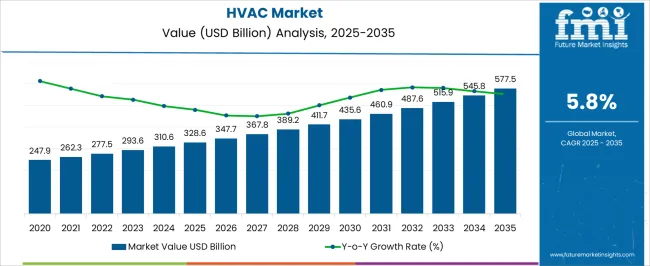
| Metric | Value |
|---|---|
| HVAC Market Estimated Value in (2025 E) | USD 328.6 billion |
| HVAC Market Forecast Value in (2035 F) | USD 577.5 billion |
| Forecast CAGR (2025 to 2035) | 5.8% |
The HVAC market is a dominant part of the broader building equipment and services industry, accounting for around 32% of the sector in 2025. At USD 328.6 billion in 2025, HVAC leads alongside segments such as lighting systems, elevators, and building controls, though its growth trajectory is stronger than most peers. The overall building equipment industry is expected to grow at a CAGR of about 4–5% between 2025 and 2035, while HVAC expands at a higher CAGR of 5.8%, highlighting its role as the primary driver of parent market revenues. Within building equipment, HVAC captures nearly 35% of spending by 2030 as rising installation volumes in residential, commercial, and industrial projects elevate its contribution.
By 2035, HVAC is projected to represent approximately 37% of the building equipment sector, reaching USD 577.5 billion. Its consistent expansion is supported by strong replacement cycles, greater integration into infrastructure projects, and stable demand across developed and emerging markets. This progression underscores HVAC’s role not only as a revenue anchor but also as a long-term stabilizer for the broader parent market, solidifying its position as one of the most critical components of global building equipment and services.
The HVAC market is advancing steadily, supported by increasing urbanization, infrastructure development, and growing awareness regarding indoor air quality. The sector is currently shaped by strong demand from both developed and developing regions, driven by energy-efficient solutions and regulatory requirements aimed at reducing carbon emissions. Technological innovation, including smart HVAC systems and advanced control mechanisms, is influencing purchasing decisions, leading to higher replacement rates and retrofit installations.
Climatic variability and rising disposable incomes are further contributing to market expansion, particularly in residential and commercial spaces. As construction activities accelerate, new building projects are incorporating HVAC systems as standard, boosting installation volumes. In parallel, government incentives for adopting energy-efficient models are positively impacting replacement demand.
The future outlook indicates a stable growth trajectory, with integrated, connected, and sustainable HVAC solutions expected to dominate. This positioning reflects the market’s adaptability to evolving environmental standards and its pivotal role in enabling thermal comfort and air quality control across multiple end-use sectors.
The hvac market is segmented by product type, end use, installation, distribution channel, and geographic regions. By product type, hvac market is divided into Heating equipment, Ventilation equipment, Air conditioning equipment, Chillers, and Cooling towers. In terms of end use, hvac market is classified into Residential, Commercial, and Industrials. Based on installation, hvac market is segmented into New construction and Replacement/Retrofit. By distribution channel, hvac market is segmented into Direct sales and Indirect sales. Regionally, the hvac industry is classified into North America, Latin America, Western Europe, Eastern Europe, Balkan & Baltic Countries, Russia & Belarus, Central Asia, East Asia, South Asia & Pacific, and the Middle East & Africa.
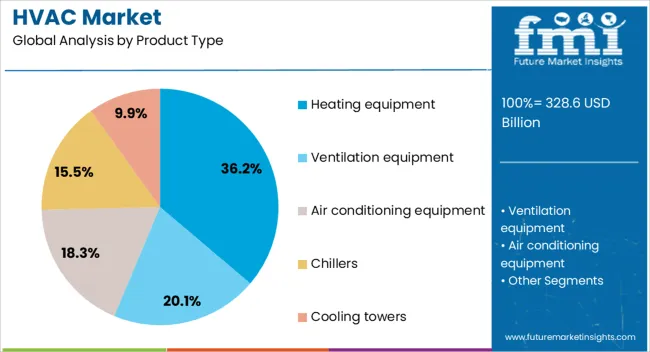
The heating equipment segment accounts for approximately 36.2% of the HVAC market, reflecting its critical role in regions with colder climates and seasonal heating needs. Demand in this segment is driven by residential and commercial installations, supported by advancements in high-efficiency furnaces, boilers, and heat pumps. The adoption of smart thermostats and variable-speed technology has enhanced the energy efficiency of heating equipment, aligning with government regulations and consumer preference for lower operational costs.
Manufacturers are increasingly focusing on low-emission designs and renewable-compatible systems, reinforcing the segment’s relevance in sustainable construction. The availability of diverse capacity ranges and easy integration into building management systems has strengthened market adoption.
Moreover, retrofitting older systems with high-efficiency models is gaining traction, particularly in regions with aging infrastructure. The heating equipment segment’s continued leadership is expected to be sustained by innovation, regulatory alignment, and its necessity for thermal comfort in both residential and commercial environments.
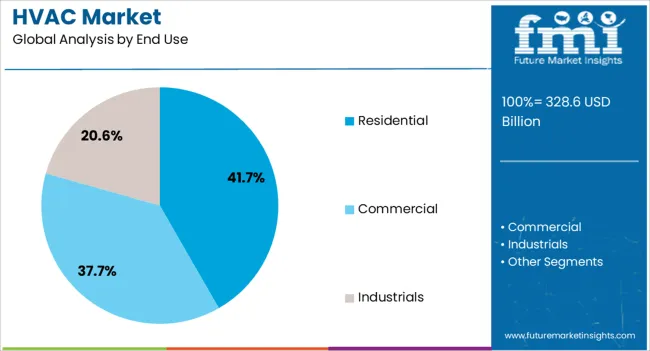
The residential segment holds approximately 41.7% of the HVAC market, underpinned by growing urban housing demand, increasing disposable incomes, and evolving consumer expectations for home comfort. Rising awareness about indoor air quality and energy-efficient systems has led to a surge in installations of advanced residential HVAC solutions, including zoned systems and integrated air purification technologies. This segment benefits from new housing developments, government incentives for energy efficiency, and heightened renovation activities.
Additionally, the expansion of the middle-class population in emerging economies has created significant opportunities for market penetration. In developed markets, the focus has shifted towards upgrading existing systems to meet stricter environmental and energy performance standards.
The popularity of smart, connected systems that allow remote control and monitoring has further enhanced residential adoption rates. As living standards improve and sustainability considerations intensify, the residential segment is positioned to maintain its leading market share through the forecast period.
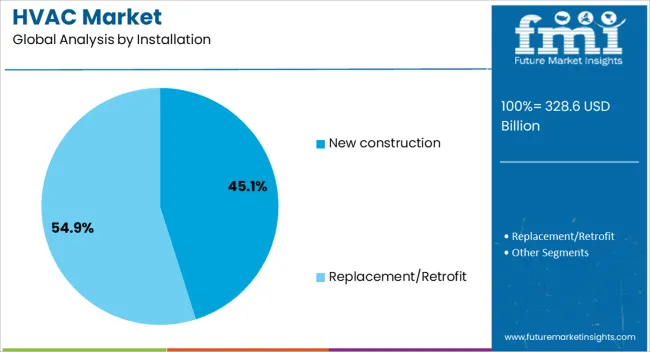
The new construction segment commands approximately 45.1% of the HVAC market, driven by a surge in global building activity and the integration of HVAC systems into initial project designs. Developers and contractors increasingly specify high-efficiency, environmentally friendly systems to meet evolving building codes and energy performance regulations. The inclusion of HVAC infrastructure during the construction phase ensures optimized system design, reduced installation costs, and better integration with modern building automation platforms.
Growth in urbanization, commercial complexes, and large-scale residential projects continues to underpin demand in this segment. Furthermore, sustainability-focused construction trends, such as green buildings and LEED-certified projects, are promoting the installation of advanced HVAC technologies from the outset.
In emerging economies, large-scale infrastructure investments are also expanding the new construction pipeline. With continued emphasis on energy performance, environmental compliance, and occupant comfort, the new construction segment is expected to sustain its leading position in the HVAC market over the coming years.
The HVAC market is expanding worldwide, supported by urbanization, rising construction activity, and demand for energy-efficient climate control solutions. North America and Europe lead with retrofitting programs and strict energy standards, while Asia-Pacific drives growth through rapid infrastructure development and higher disposable incomes. Manufacturers focus on smart systems, modular designs, and refrigerant transitions in line with environmental regulations. Differences in consumer affordability, climate zones, and regulatory priorities strongly shape adoption patterns, product innovation, and global competitiveness within the HVAC industry.
Energy regulations remain a decisive factor shaping the HVAC market, particularly in North America and Europe where strict performance mandates are in place. The USA Department of Energy and European Union standards push manufacturers to deliver high-efficiency air conditioners, heat pumps, and ventilation systems. This contrasts with Asia-Pacific, where regulatory frameworks are still evolving, and demand is largely driven by rising urbanization and comfort requirements. Differences in enforcement levels lead to variation in technology deployment: developed markets favor advanced variable-speed compressors, inverter-driven systems, and eco-friendly refrigerants, while emerging markets balance efficiency with affordability. Global leaders heavily invest in R&D to meet efficiency and emissions benchmarks, while regional players compete on cost. These contrasting priorities define the industry’s product development strategies and drive distinct adoption paths across regions, underscoring the pivotal role of regulatory pressure in HVAC growth worldwide.
The rapid pace of urbanization and infrastructure development significantly boosts HVAC system adoption. Asia-Pacific leads in new installations, with massive demand generated by commercial complexes, residential towers, and public infrastructure projects across China, India, and Southeast Asia. In contrast, North America and Europe rely heavily on retrofit and upgrade markets, targeting older buildings requiring modernization. This divide in demand patterns leads manufacturers to design scalable systems that serve both new construction and retrofitting needs. Global players emphasize modular, compact units suited for dense urban environments, while regional producers often cater to cost-sensitive residential markets. The growth of smart cities and eco-friendly building initiatives further amplifies demand for HVAC solutions tailored to energy-efficient construction. Urbanization contrasts highlight the balance between high-volume, new-installation markets in developing regions and high-value, retrofit-heavy opportunities in mature economies, shaping competitive strategies across the industry.
Geographical climate differences strongly influence HVAC system adoption and product design. In hot and humid regions such as the Middle East and Asia-Pacific, cooling systems dominate demand, with central air conditioners and split units leading installations. Conversely, colder climates in Europe and North America prioritize heating technologies such as furnaces, boilers, and heat pumps. These regional contrasts drive specialized innovation: companies serving warm regions develop advanced cooling efficiency and low-maintenance systems, while suppliers in colder markets focus on hybrid solutions combining heating and cooling. Emerging economies often prefer affordable, single-function products, while advanced markets demand multi-functional, energy-optimized systems. Seasonal peaks also affect sales cycles differently across regions, influencing supply chain management and production planning. This climate-driven divergence in HVAC adoption highlights how manufacturers must customize their offerings to align with local comfort needs, affordability, and environmental conditions.
The integration of digital technologies is redefining HVAC system competitiveness. In North America and Europe, demand for IoT-enabled, sensor-driven HVAC systems capable of predictive maintenance, energy optimization, and remote control is surging. These regions prioritize connectivity to reduce lifecycle costs and improve sustainability. Asia-Pacific markets, while still price-sensitive, are gradually adopting smart HVAC systems in premium residential projects and commercial complexes, particularly in urban centers. The differences in adoption speed reflect varying infrastructure maturity and consumer expectations. Manufacturers that offer scalable solutions from affordable units with basic efficiency upgrades to advanced connected systems capture broader markets. Partnerships with building automation providers and integration with smart home ecosystems further enhance adoption in developed regions. This divide between digitally advanced markets and cost-focused economies underscores the importance of flexibility in product design, enabling manufacturers to balance innovation with affordability.
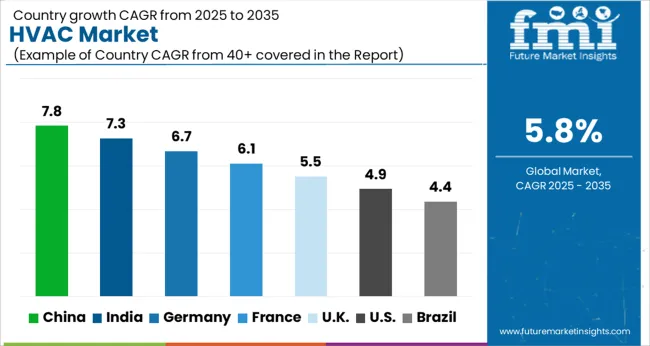
| Country | CAGR |
|---|---|
| China | 7.8% |
| India | 7.3% |
| Germany | 6.7% |
| France | 6.1% |
| UK | 5.5% |
| USA | 4.9% |
| Brazil | 4.4% |
The global HVAC market is expected to expand at a 5.8% CAGR through 2035, driven by rising demand in residential, commercial, and industrial applications. Among BRICS nations, China led with 7.8% growth as large-scale manufacturing and deployment of HVAC systems accelerated to meet urbanization and infrastructure needs, while India at 7.3% strengthened installation capacity to cater to expanding construction sectors. In the OECD region, Germany at 6.7% maintained robust output under stringent efficiency and environmental standards, while the United Kingdom at 5.5% supported moderate adoption across residential and commercial facilities. The USA, advancing at 4.9%, continued steady integration of HVAC systems, aligning with federal and state-level energy efficiency regulations. This report includes insights on 40+ countries; the top countries are shown here for reference.
The HVAC market in China is growing at a 7.8% CAGR, driven by rapid urbanization, rising disposable incomes, and expansion of commercial and residential infrastructure. Increasing demand for energy-efficient systems is encouraged by government regulations targeting sustainable construction and reduced emissions. Commercial complexes, shopping malls, hospitals, and educational institutions are adopting advanced HVAC technologies to ensure comfort and operational efficiency. Domestic manufacturers are expanding production capabilities while investing in innovative solutions such as smart HVAC and variable refrigerant flow systems. E-commerce platforms and retail distribution networks are improving accessibility across major cities and smaller towns. Overall, China’s HVAC market reflects strong momentum fueled by construction growth, regulatory support, and rising consumer preference for efficient climate control solutions.
HVAC market in India is registering a 7.3% CAGR, supported by rapid urbanization, rising middle-class income, and growing demand across commercial and residential segments. Expansion of retail malls, healthcare centers, and office complexes is fueling consistent adoption of HVAC systems. Government initiatives promoting energy efficiency and green buildings further drive the shift toward modern, eco-friendly solutions. Domestic and international manufacturers are competing by offering affordable, durable, and climate-adapted systems tailored for India’s diverse weather conditions. Distribution networks are expanding through retail chains and e-commerce platforms, making advanced HVAC systems accessible in tier-1 and tier-2 cities. The market shows strong potential, supported by infrastructure growth and rising awareness of indoor air quality.
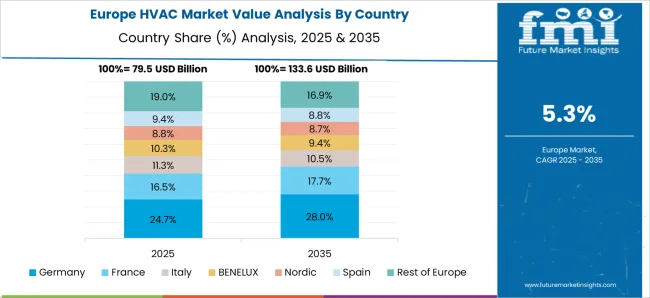
HVAC market in Germany is expanding at a 6.7% CAGR, influenced by stringent EU regulations on energy efficiency and emission reduction. Commercial facilities, educational institutions, and industrial plants are upgrading systems to meet sustainability standards. There is growing demand for heat pumps, smart climate control, and hybrid HVAC solutions that align with the country’s renewable energy transition. Manufacturers focus on high-quality, durable systems with advanced monitoring features that ensure cost savings and compliance. Adoption is also rising in residential segments, supported by government incentives for energy-efficient retrofits. Germany’s HVAC market reflects a strong alignment with environmental goals, technological advancement, and regulatory frameworks.
The HVAC market in the United Kingdom is growing at a 5.5% CAGR, driven by modernization of commercial and residential infrastructure and the push for sustainable energy solutions. Government policies targeting carbon reduction and improved building efficiency are encouraging replacement of older systems with modern HVAC technologies. Demand is rising across office buildings, healthcare centers, and hospitality facilities where climate control is essential. Manufacturers are introducing compact, efficient, and cost-effective systems designed to meet evolving regulatory requirements. Distribution networks, including online platforms, are enhancing accessibility across urban and suburban areas. The market reflects steady growth with emphasis on efficiency, sustainability, and improved comfort.
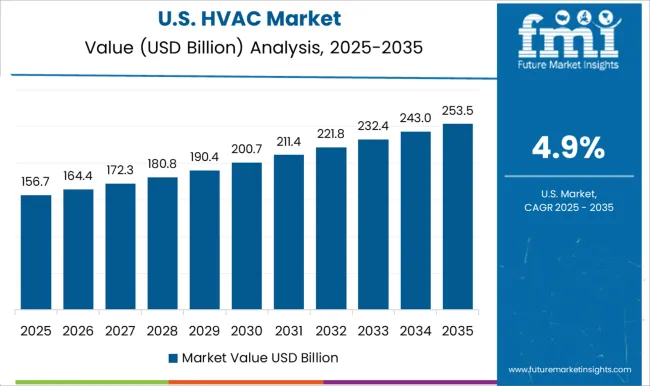
The United States HVAC market is registering a 4.9% CAGR, supported by rising demand for efficient heating and cooling solutions across residential, commercial, and industrial facilities. Modernization of aging infrastructure and the transition toward smart and energy-efficient buildings are key drivers. Manufacturers are innovating with systems that integrate smart thermostats, variable-speed compressors, and advanced monitoring features to reduce energy use and improve comfort. Growing awareness of indoor air quality is encouraging adoption in healthcare, education, and office complexes. Distribution channels include direct retail, specialized suppliers, and online stores, ensuring broad accessibility. The USA HVAC market reflects steady growth shaped by technological innovation, infrastructure modernization, and consumer preference for efficient climate solutions.
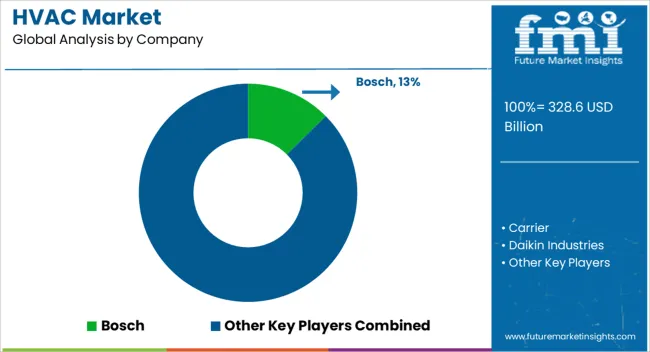
The global HVAC (Heating, Ventilation, and Air Conditioning) market is driven by leading companies that focus on innovation, energy efficiency, and sustainable climate solutions. Bosch, Carrier, and Daikin Industries are among the most recognized suppliers, offering advanced heating and cooling technologies that cater to both residential and commercial applications. These companies are heavily investing in smart HVAC systems and environmentally friendly refrigerants to align with stricter energy regulations and the rising demand for green building solutions. Other significant players such as Danfoss, GREE Electric Appliances, Haier, and Hisense HVAC Equipment strengthen the market by providing a wide range of products designed for high performance and cost efficiency. Their offerings include central air conditioning, variable refrigerant flow (VRF) systems, and integrated ventilation solutions that support urban infrastructure and industrial operations. With rapid urbanization and the push toward energy-efficient buildings, these suppliers are expanding their reach globally through innovation and partnerships. Additionally, companies like Johnson Controls, Lennox International, LG Electronics, Midea, Mitsubishi Electric, and Panasonic continue to lead with smart technologies and IoT-enabled HVAC solutions. These firms emphasize connectivity, automation, and energy savings, making their systems suitable for smart homes, offices, and large-scale industrial facilities. Their commitment to sustainability and technological advancement ensures they remain key players in shaping the future of the HVAC industry worldwide.
| Item | Value |
|---|---|
| Quantitative Units | USD 328.6 Billion |
| Product Type | Heating equipment, Ventilation equipment, Air conditioning equipment, Chillers, and Cooling towers |
| End Use | Residential, Commercial, and Industrials |
| Installation | New construction and Replacement/Retrofit |
| Distribution Channel | Direct sales and Indirect sales |
| Regions Covered | North America, Europe, Asia-Pacific, Latin America, Middle East & Africa |
| Country Covered | United States, Canada, Germany, France, United Kingdom, China, Japan, India, Brazil, South Africa |
| Key Companies Profiled | Bosch, Carrier, Daikin Industries, Danfoss, GREE Electric Appliances, Haier, Hisense HVAC equipment, Johnson Controls, Lennox International, LG Electronics, Midea, Mitsubishi Electric, and Panasonic |
| Additional Attributes | Dollar sales vary by system type, including heating, ventilation, air conditioning, and integrated HVAC solutions; by technology, such as central, split, and packaged systems; by application, spanning residential, commercial, and industrial buildings; by region, led by North America, Europe, and Asia-Pacific. Growth is driven by urbanization, energy efficiency regulations, smart building adoption, and rising construction activities. |
The global hvac market is estimated to be valued at USD 328.6 billion in 2025.
The market size for the hvac market is projected to reach USD 577.5 billion by 2035.
The hvac market is expected to grow at a 5.8% CAGR between 2025 and 2035.
The key product types in hvac market are heating equipment, _furnaces, _boiler, _heat pumps, ventilation equipment, _air handlers, _ductwork, _fans, air conditioning equipment, chillers and cooling towers.
In terms of end use, residential segment to command 41.7% share in the hvac market in 2025.






Our Research Products

The "Full Research Suite" delivers actionable market intel, deep dives on markets or technologies, so clients act faster, cut risk, and unlock growth.

The Leaderboard benchmarks and ranks top vendors, classifying them as Established Leaders, Leading Challengers, or Disruptors & Challengers.

Locates where complements amplify value and substitutes erode it, forecasting net impact by horizon

We deliver granular, decision-grade intel: market sizing, 5-year forecasts, pricing, adoption, usage, revenue, and operational KPIs—plus competitor tracking, regulation, and value chains—across 60 countries broadly.

Spot the shifts before they hit your P&L. We track inflection points, adoption curves, pricing moves, and ecosystem plays to show where demand is heading, why it is changing, and what to do next across high-growth markets and disruptive tech

Real-time reads of user behavior. We track shifting priorities, perceptions of today’s and next-gen services, and provider experience, then pace how fast tech moves from trial to adoption, blending buyer, consumer, and channel inputs with social signals (#WhySwitch, #UX).

Partner with our analyst team to build a custom report designed around your business priorities. From analysing market trends to assessing competitors or crafting bespoke datasets, we tailor insights to your needs.
Supplier Intelligence
Discovery & Profiling
Capacity & Footprint
Performance & Risk
Compliance & Governance
Commercial Readiness
Who Supplies Whom
Scorecards & Shortlists
Playbooks & Docs
Category Intelligence
Definition & Scope
Demand & Use Cases
Cost Drivers
Market Structure
Supply Chain Map
Trade & Policy
Operating Norms
Deliverables
Buyer Intelligence
Account Basics
Spend & Scope
Procurement Model
Vendor Requirements
Terms & Policies
Entry Strategy
Pain Points & Triggers
Outputs
Pricing Analysis
Benchmarks
Trends
Should-Cost
Indexation
Landed Cost
Commercial Terms
Deliverables
Brand Analysis
Positioning & Value Prop
Share & Presence
Customer Evidence
Go-to-Market
Digital & Reputation
Compliance & Trust
KPIs & Gaps
Outputs
Full Research Suite comprises of:
Market outlook & trends analysis
Interviews & case studies
Strategic recommendations
Vendor profiles & capabilities analysis
5-year forecasts
8 regions and 60+ country-level data splits
Market segment data splits
12 months of continuous data updates
DELIVERED AS:
PDF EXCEL ONLINE
HVAC UV Sanitizer Market Size and Share Forecast Outlook 2025 to 2035
HVAC Coil Coating Market Size and Share Forecast Outlook 2025 to 2035
HVAC Control System Market Size and Share Forecast Outlook 2025 to 2035
HVAC Valve Market Size and Share Forecast Outlook 2025 to 2035
HVAC Air Quality Monitoring Market Size and Share Forecast Outlook 2025 to 2035
HVAC Centrifugal Compressors Market Size and Share Forecast Outlook 2025 to 2035
HVAC Fan & Evaporator Coil Market Size and Share Forecast Outlook 2025 to 2035
HVAC System Analyzer Market Size and Share Forecast Outlook 2025 to 2035
HVAC Software Market Analysis - Size, Share, and Forecast Outlook for 2025 to 2035
HVAC Insulation Market Trends & Forecast 2025 to 2035
HVAC Blower and Fan Systems Market Growth - Trends & Forecast 2025 to 2035
Smart HVAC Controls Market Size and Share Forecast Outlook 2025 to 2035
Marine HVAC System Market Size and Share Forecast Outlook 2025 to 2035
Global HVAC Filter Market
Demand for HVAC Software in USA Size and Share Forecast Outlook 2025 to 2035
Demand for HVAC Software in Japan Size and Share Forecast Outlook 2025 to 2035
Automotive HVAC Blower Market Trends - Size, Share & Growth 2025 to 2035
Automotive HVAC Ducts Market Growth - Trends & Forecast 2025 to 2035
Antimicrobial HVAC Coating Market Size and Share Forecast Outlook 2025 to 2035
Latin America Automotive HVAC Market Size and Share Forecast Outlook 2025 to 2035

Thank you!
You will receive an email from our Business Development Manager. Please be sure to check your SPAM/JUNK folder too.
Chat With
MaRIA